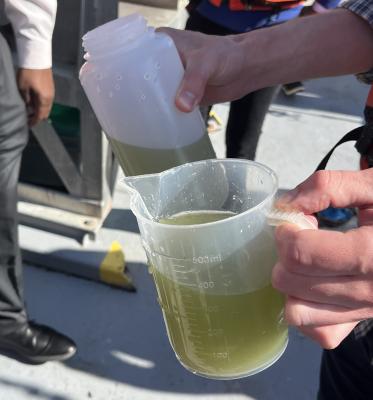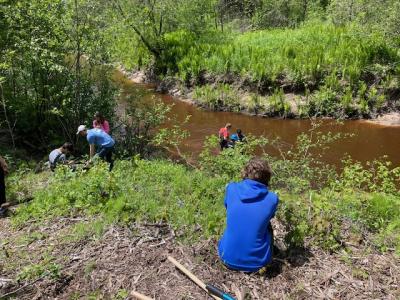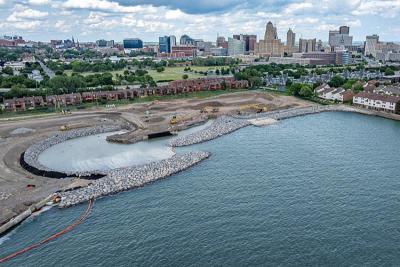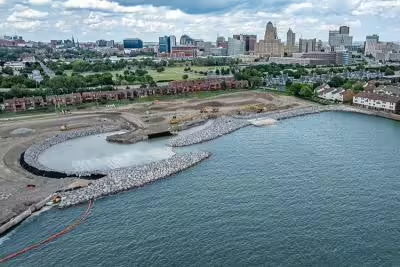Category: Other
Great Lakes Restoration Initiative Emerald Shiner Fish Passage Project
Great Lakes Restoration Initiative Emerald Shiner Fish Passage Project
josterme01
Wed, 10/16/2024 – 3:07 pm

With funding from the EPA’s Great Lakes Restoration Initiative (GLRI), the US Army Corps of Engineers (USACE), Buffalo District, will build a 700-foot-long fish passage at the City of Buffalo’s Freedom Park on Unity Island. The emerald shiner is a small, but critical prey fish at the base of the food web in the Niagara River and Lake Erie. The high velocity of the Niagara River along the current seawall creates a barrier that the emerald shiners cannot pass to reach Lake Erie. Once the project is complete, the emerald shiner will be able to move upstream after spawning, providing a critical food source for larger fish and wildlife, offering sustenance for the local community, and contributing to goals for delisting the Niagara River as an EPA Area of Concern (AOC). The New York State Department of Environmental Conservation is the Niagara River AOC Remedial Action Plan Coordinator and with input from agencies and local partners, selected this project as a management action for the Loss of Fish and Wildlife Habitat Beneficial Use Impairment (BUI).
To reduce the river velocity along the seawall, a contractor will install steel plates, or metal baffles, within two feet above and below the typical waterline. In 2022, a demonstration project testing the effectiveness of this approach included the installation of the metal baffles along the most downstream 78 feet of seawall. Following installation, the USACE monitored the metal baffles for stability, reduction of water velocity, and to ensure the emerald shiner could pass. The demonstration project was deemed a success and lessons learned were incorporated into the design for the remaining portion of seawall.
The USACE Buffalo District recently awarded an $11.8M contract to complete construction of the remainder of the project, which will include repairs where necessary along the remaining 700 feet of seawall and the installation of the metal baffles. Construction is scheduled to begin late winter 2024 and be completed by December 2026. This will include both landside and in water work along the seawall. The improvements of passage for the emerald shiners will help to restore fish communities and contribute to removal of the Fish and Wildlife Habitat BUI.
To read the full announcement, please visit USACE Buffalo District.
The Kincardine Independent
(By Pauline Kerr) The Grey Bruce Board of Health has endorsed a letter from the Association of Local Public Health Agencies (alPHa), sent to Ontario Health Minister Sylvia Jones, concerning … Continue reading Grey-Bruce board of health discusses province’s new addiction treatment model
The post Grey-Bruce board of health discusses province’s new addiction treatment model appeared first on Kincardine Independent.
The Kincardine Independent
(By Liz Small) Design ideas for the refurbishment of Victoria Park were unveiled at a come-and-go event held Tuesday, Oct. 1 at the Kincardine Davidson Centre. To read the entire … Continue reading New look for Victoria Park unveiled at open house
The post New look for Victoria Park unveiled at open house appeared first on Kincardine Independent.
The Kincardine Independent
The Grey-Bruce board of health prioritizes a high immunization rate to prevent serious respiratory illnesses. A report presented at the Sept. 27 meeting of the Grey-Bruce board of health provided … Continue reading Tis the season to protect yourself and your loved ones from respiratory illnesses
The post Tis the season to protect yourself and your loved ones from respiratory illnesses appeared first on Kincardine Independent.
EPA Announces $4 Million Funding Opportunity for Phosphorus Reduction Efforts in Western Lake Erie Basin
EPA Announces $4 Million Funding Opportunity for Phosphorus Reduction Efforts in Western Lake Erie Basin
josterme01
Fri, 09/27/2024 – 4:08 pm

U.S. Environmental Protection Agency has announced the availability of $4 million in Great Lakes Restoration Initiative funding to support phosphorus reduction efforts in the western Lake Erie basin through farmer outreach and technical assistance. Applications will be accepted until November 22, 2024.
The western basin of Lake Erie experiences harmful algal blooms each summer. Reducing phosphorus loading from the surrounding watershed is expected to substantially reduce the extent of harmful algal blooms. The primary objective of this funding opportunity is to increase the resources available to help farmers improve their nutrient management.
Learn about eligibility, western Lake Erie Basin watershed definitions, application and webinar information on EPA’s 2024 Notice of Funding Opportunity webpage.
The Kincardine Independent
Huron Shores Hospice held its largest annual fundraising event, Handbags for Hospice, at the Kincardine Pavilion on Thursday, Sept. 19. The evening raised over $170,000 in support of the two-bedroom … Continue reading Handbags for Hospice raises a whopping $170,000
The post Handbags for Hospice raises a whopping $170,000 appeared first on Kincardine Independent.
NOAA’s Great Lakes Bay Watershed Education and Training Program Announces 2024 Awards
NOAA’s Great Lakes Bay Watershed Education and Training Program Announces 2024 Awards
josterme01
Fri, 09/20/2024 – 1:02 pm

NOAA Great Lakes Bay Watershed Education and Training (B-WET) program announced $652,117 in funding for seven environmental education projects throughout the Great Lakes basin. Great Lakes B-WET awards are funded through the Great Lakes Restoration Initiative (GLRI). Each project will address one of the three priority areas of the Great Lakes B-WET program: (1) new projects that use the Meaningful Watershed Educational Experiences framework (MWEE), (2) Systemic MWEE Implementation, or (3) Capacity building for expanded statewide K-12 environmental literacy initiatives.
The funded projects throughout the Great Lakes basin are:
- Cuyahoga Soil and Water Conservation District: Implementing Meaningful Watershed Educational Experiences in the Tinker’s Creek Watershed
- Friends of the St. Clair River: St. Clair River Watershed Pen Pals: From Creeks to Coast
- Great Lakes Stewardship Initiative: Advancing K-12 Environmental Literacy through Place-Based Stewardship Education (PBSE) in Michigan and the Great Lakes Region
- Huron-Clinton Metropolitan Authority: Science and Stewardship in the Heart of the Great Lakes
- ODC Network: River Keepers: Understanding the Impacts of Human Activity and Climate Change on Local Watersheds
- Riveredge Nature Center Inc: Water Journeys: Empowering Middle-Schoolers to Improve the Milwaukee River
- University of Michigan at Ann Arbor: Climate Change in the Bay: Designing Meaningful Student Experiences in the Saginaw Bay Watershed
Read more about each of these projects, and projects funded in previous years, at https://sanctuaries.noaa.gov/bwet/greatlakes/
NOAA B-WET is an environmental education program that promotes place-based experiential learning for K-12 students and related professional development for teachers. B-WET fosters the growth of new, innovative programs and encourages capacity-building and environmental education partnerships. The primary delivery of B-WET is through competitive grants that promote Meaningful Watershed Educational Experiences (MWEEs). The MWEE is a learner-centered framework that focuses on investigations into local environmental issues and leads to informed stewardship action.
For more information about Great Lakes B-WET, please contact Sarah Waters (sarah.a.waters@noaa.gov).
$4.2 Million Recommended for Great Lakes Habitat Restoration
$4.2 Million Recommended for Great Lakes Habitat Restoration
josterme01
Wed, 09/18/2024 – 2:30 pm

NOAA Fisheries is recommending $4.2 million in Great Lakes Restoration Initiative funding to continue ongoing work restoring important habitat in the Great Lakes. Through this funding, partners will implement projects that support fisheries, habitats, and communities in Great Lakes ecosystems.
NOAA Fisheries is recommending funding to continue the work of three ongoing cooperative agreements:
- Ducks Unlimited will develop plans to restore wetland habitat at Camp Sabroske in Ohio, contributing toward restoring the Maumee Area of Concern. ($752,000)
- The Great Lakes Commission will implement several high priority habitat restoration projects in the Great Lakes region, including in the Maumee Area of Concern in Ohio and the Niagara River Area of Concern in New York. ($3.1 million)
- Genesee County, Michigan, will contribute to the removal of the Hamilton Dam on the Flint River, opening nearly 25 miles to fish passage. ($341,000)
As the largest freshwater system on earth, the Great Lakes are one of the most important natural resources in the world. They support valuable commercial, recreational, and tribal fisheries, as well as industry, transportation, and tourism. This funding will help sustain the many benefits the Great Lakes provide to the environment and communities by:
- Supporting valuable fisheries and coastal resources
- Improving the quality of our water by restoring coastal wetlands
- Providing recreational opportunities for people to use and enjoy
- Increasing the resilience of Great Lakes communities
The Office of Habitat Conservation’s NOAA Restoration Center works in the Great Lakes to support the ecosystems and economies that rely on these valuable international resources. Since 2010, we have supported 98 projects through the Great Lakes Restoration Initiative. These projects have restored more than 5,100 acres of habitat for fish and wildlife and opened more than 520 miles of rivers and streams to fish migration.
The Kincardine Independent
Decision made at last week’s council meeting The long-awaited decision as to the fate of the Dr. Solomon Secord monument was made at the Kincardine Council meeting on Sept. 11. … Continue reading Dr. Secord monument to be destroyed
The post Dr. Secord monument to be destroyed appeared first on Kincardine Independent.
One moment, please…
Please wait while your request is being verified…



